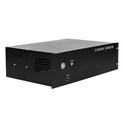Hey there, fellow lab enthusiasts! I'm a supplier of ResoLab lab grade ultrasonicator, and today I want to dig into a question that often pops up in the scientific community: Can the ResoLab - lab grade ultrasonicator be used for DNA shearing?
Let's first understand what DNA shearing is. In simple terms, DNA shearing is the process of breaking long strands of DNA into smaller fragments. This is a crucial step in many molecular biology techniques, like next - generation sequencing (NGS), chromatin immunoprecipitation sequencing (ChIP - seq), and gene editing. Smaller DNA fragments are easier to handle, sequence, and analyze.
Now, let's talk about how ultrasonication works. Ultrasonication uses high - frequency sound waves to generate cavitation bubbles in a liquid. When these bubbles collapse, they create intense local forces, including high pressures and shear forces. These forces can break chemical bonds and disrupt biological structures. In the context of DNA shearing, the shear forces generated by the collapsing cavitation bubbles can break the long DNA strands into smaller pieces.
So, can our ResoLab lab grade ultrasonicator do the job? The answer is a big yes! Our ultrasonicator is designed to provide precise and controllable ultrasonic energy, which is essential for effective DNA shearing.
One of the key advantages of our ResoLab ultrasonicator is its adjustable power output. Different DNA samples may require different levels of energy for optimal shearing. For example, if you're working with a more robust DNA sample, you might need a higher power setting to break the strands effectively. On the other hand, a more delicate sample could be damaged by too much energy, so a lower power setting would be more appropriate. Our ResoLab - 500 Lab Grade Ultrasonicator offers a relatively lower power range, which is great for small - scale experiments or samples that are more sensitive. It allows you to fine - tune the energy input to get the desired DNA fragment size.
The ResoLab - 1000 Lab Grade Ultrasonicator provides a mid - range power output. This is suitable for a wide variety of DNA shearing applications, whether you're working in a research lab or a small - scale production environment. It gives you the flexibility to handle different types of samples and achieve consistent results.
For larger - scale operations or more demanding DNA shearing tasks, our ResoLab - 2000 Lab Grade Ultrasonicator is the go - to option. With its higher power capacity, it can quickly and efficiently shear large volumes of DNA samples. This is especially useful in industrial settings or large - scale sequencing projects where time is of the essence.
Another important feature of our ResoLab ultrasonicator is its precise time control. The duration of ultrasonication is also a critical factor in DNA shearing. If you sonicate for too short a time, the DNA strands may not be broken down enough. Conversely, over - sonication can lead to excessive fragmentation or damage to the DNA. Our ultrasonicator allows you to set the exact time for the ultrasonication process, ensuring that you get the right fragment size every time.
Temperature control is also a major concern when it comes to DNA shearing. Ultrasonication generates heat, and high temperatures can denature the DNA. Our ResoLab ultrasonicator is equipped with a cooling system to maintain a stable temperature during the shearing process. This helps to preserve the integrity of the DNA and ensures reliable results.
In addition to these technical features, our ResoLab ultrasonicator is also user - friendly. It has a simple interface that makes it easy for both experienced researchers and newbies to operate. You don't need to be a technical expert to use our ultrasonicator effectively.
Now, let's look at some real - world examples. Many research labs have already started using our ResoLab ultrasonicator for DNA shearing, and the feedback has been overwhelmingly positive. For instance, a research team working on a gene - editing project used our ResoLab - 1000 Lab Grade Ultrasonicator to shear their DNA samples. They were able to achieve the desired fragment size with high reproducibility, which was crucial for their subsequent experiments.
Another group in an industrial setting was working on a large - scale sequencing project. They chose our ResoLab - 2000 Lab Grade Ultrasonicator for its high - power capacity and fast processing speed. The ultrasonicator helped them to complete their shearing tasks in a timely manner, which significantly accelerated their project timeline.
If you're still not convinced, you can also do some preliminary tests. We can provide you with a demonstration unit so that you can see for yourself how our ResoLab ultrasonicator performs in your own lab environment. You can try different power settings, time durations, and sample types to find the optimal conditions for your DNA shearing needs.
In conclusion, our ResoLab lab grade ultrasonicator is an excellent choice for DNA shearing. It offers adjustable power, precise time control, temperature regulation, and user - friendly operation. Whether you're in a small research lab or a large - scale industrial facility, our ultrasonicator can meet your DNA shearing requirements.
If you're interested in learning more about our ResoLab ultrasonicator or are thinking about making a purchase, don't hesitate to reach out. We're here to answer all your questions and help you find the best solution for your lab. Let's start a conversation and see how our ultrasonicator can take your DNA shearing experiments to the next level.


References
- "Ultrasonication in Molecular Biology: Principles and Applications" - A general review article on the use of ultrasonication in biological research.
- "Optimization of DNA Shearing for Next - Generation Sequencing" - A research paper focusing on the factors affecting DNA shearing and how to optimize the process.





